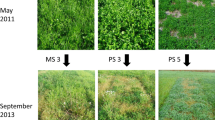Abstract
The productivity of short-leaved and long-leaved perennial ryegrass was evaluated in 5 different sites. In each site, half-sib families, derived from the first cycle of divergent selection on leaf length, were managed both under infrequent cutting and under frequent cutting simulating grazing. Despite the importance of the effects of the site and the cutting frequency, the dry matter yield was dependent on the interaction between the morphogenetic type resulting from the selection and the cutting frequency imposed by the management. Thus, under infrequent cutting, the long-leaved families on average out-yielded the short-leaved families. Conversely, under frequent cutting the short-leaved families were on average the most productive. The use of morphogenetic traits as selection criteria in breeding for management-dependent yield is briefly discussed.
Similar content being viewed by others
References
Donald, C.M., 1968. The breeding of crop ideotypes. Euphytica 17: 385–403.
Gillet, M., 1980. Les graminées fourragères. Bordas (Ed.), Paris.
Hazard, L., M. Ghesquière & M. Betin, 1994. Breeding for management adaptation in perennial ryegrass (Lolium perenne L.) I. Assessment of yield under contrasting cutting frequencies and relationships with leaf morphogenesis components. Agronomie 14: 259–266.
Hazard, L., J.C. Emile, M. Ghesquière & X. Charrier, 1995. Varietal effect in perennial ryegrass on milk productivity of dairy cows in continuous grazing: turf variety vs. forage variety. Annales de Zootechnie 44Suppl: 367.
Hazard, L. & M. Ghesquière, 1995. Evidence from the use of isozyme markers of competition in swards between short-leaved and long-leaved perennial ryegrass. Grass and Forage Sci 50: 241–248.
Hazard, L., M. Ghesquière & C. Barraux, 1996. Genetic variability for leaf development in perennial ryegrass populations. Can J Plant Sci 76: 113–118.
Hill, J., K. Mather & P.D.S. Caligari, 1987. Analysis of competitive ability among genotypes of perennial ryegrass. II. Effect upon dry matter production. Euphytica 36: 109–115.
Horst, G.L., C.J. Nelson & K.H. Asay, 1978. Relationship of leaf elongation to forage yield of tall fescue genotypes. Crop Sci 18: 715–719.
Lemaire, G., C. Varlet-Granchet, F. Gastal & J.L. Durand, 1987. Ecophysiological approach to plant growth. Consequences for breeding strategies for forage species in contrasting conditions and different managements. Proc 14th Meeting Fodder Crops Section of EUCARPIA, Lusignan, France: 103–118.
Lemaire, G., 1991. Productivité des peuplements prairiaux: caractérisation et diagnostic. Fourrages 127: 259–272.
Parsons, A.J. & M.J. Robson, 1982. Seasonal changes in the physiology of S24 perennial ryegrass. 4. Comparison of the carbon balance of the reproductive crop in spring and the vegetative crop in autumn. Ann Bot 50: 167–177.
Parsons, A.J., E.L. Leafe, B. Collett, P.D. Penning & J. Lewis, 1983. The physiology of grass production under grazing. II. Photosynthesis, crop growth and animal intake of continuously-grazed swards. J Appl Ecol 20: 127–139.
Rhodes, I., 1973. Relationship between canopy structure and productivity in herbage grasses and its implications for plant breeding. Herbage Abstracts 43: 129–133.
Rhodes, I. & S.S. Mee, 1980. Changes in dry matter yield associated with selection for canopy characters in rye-grass. Grass Forage Sci 35: 35–39.
SAS Institute Inc., 1989. SAS/STAT user's guide, version 6. SAS Institute (Ed.), Cary, USA.
Simons, R.G., A. Davies & A. Troughton, 1972. The effect of the height of defoliation on two clones of perennial ryegrass. J Agric Sci 79: 509–514.
Sleper, D.A. & C.J. Nelson, 1989. Productivity of selected high and low leaf area expansion Festuca arundinacea strains. Proc 16th Int Grassld Congr, Nice, France: 379–380.
Sugiyama, S., 1987. Adaptative strategy and its agronomic implications in tall fescue (Festuca arundinacea Schreb.). 2. The relationship between plant type and productivity under the different cultural conditions. Res Bul Univ Farm Hokkaido Univ 25: 43–54.
Wilkins, P.W., 1989. Genotype/harvesting frequency and genotype/nitrogen level interactions for annual dry matter yield in Lolium pernne in relation to breeding. Euphytica 41: 207–214.
Wilkins, P.W., 1991. Breeding perennial ryegrass for agriculture. Euphytica 52: 201–214.
Wilkins, P.W., 1995. Independance of dry matter yield and leaf yield among perennial ryegrass varieties differing in seasonal yield distribution. Grass Forage Sci 50: 155–161.
Author information
Authors and Affiliations
Rights and permissions
About this article
Cite this article
Hazard, L., Ghesquière, M. Productivity under contrasting cutting regimes of perennial ryegrass selected for short and long leaves. Euphytica 95, 295–299 (1997). https://doi.org/10.1023/A:1003048316012
Issue Date:
DOI: https://doi.org/10.1023/A:1003048316012




